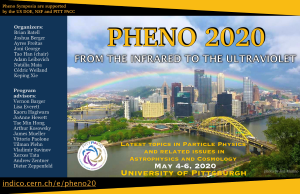Conveners
Neutrinos II
- Manimala Mitra (Institute of Physics)
The non-zero neutrino masses and the possibility of New Physics discovery drive the hunt for neutrinoless double beta decay. While searching for this hypothetical nuclear process, a significant amount of the two-neutrino double beta decay data has been collected by a number of experiments. While these events are from the particle physics viewpoint regarded and studied mainly, if not merely, as...
We include the effects of the so called long-range contributions to the neutrinoless double beta decay rate in the context of the minimal left-right symmetric model. This new contribution can be the dominant one in a considerable portion of the parameter space relevant to phenomenology. Our results show how the inclusion of this long-range effects in the decay rate, must be included in order...
Lepton number violation (LNV) is a very attractive research topic for theoretical and experimental physicists due to its implications beyond the Standard Model. It provides feasible theoretical explanations to several open questions in particle physics (e.g., the origin of neutrino mass) and also has a rich phenomenology at different energy scales. We explore the underlying connections between...
Long-lived particles are predicted in extensions of the Standard Model that involve relatively light but very weakly interacting sectors. In this paper we consider the possibility that some of these particles are produced in atmospheric cosmic ray showers, and their decay intercepted by neutrino detectors such as IceCube or Super-Kamiokande. We present the methodology and evaluate the...
A simple $SU(5)$ model is proposed that connects the neutrino mass generation mechanism to the observed disparity between the masses of charged leptons and down-type quarks. The model is built out of $5$-, $10$-, $15$-, $24$-, and $35$-dimensional representations of $SU(5)$ and comprises two (three) $3 \times 3$ ($3 \times 1$) Yukawa coupling matrices to accommodate all experimentally measured...
$SU(2)_L \times SU(2)_R$ gauge symmetry requires three right-handed neutrinos ($ N _i $), one of which, $N_1$, can be sufficiently stable to be dark matter. In the early universe, $ W _R $ exchange with the Standard Model thermal bath keeps the right-handed neutrinos in thermal equilibrium at high temperatures.
$N_1$ can make up all of dark matter if they freeze-out while relativistic and are...
We consider a version of Left-Right Symmetric Model in which the scalar sector consists of a Higgs bidoublet ($\Phi$) with $B-L=0$, Higgs doublets ($H_{L,R}$) with $B-L=1$ and a charged scalar ($\delta^+$) with $B-L=2$ leading to radiatively generated Majorana masses for neutrinos and thereby, leads to new physics contributions to neutrinoless double beta decay ($0\nu \beta \beta$). We show...
We study the new physics contributions to neutrinoless double beta decay ($0\nu\beta\beta$) in a TeV scale left-right model with spontaneous D-parity breaking mechanism where the values of the $SU(2)_L$ and $SU(2)_R$ gauge couplings, $g_L$ and $g_R$ are unequal. Neutrino mass is generated in the model via gauge extended inverse seesaw mechanism. We embed the model in a non-supersymmetric...
